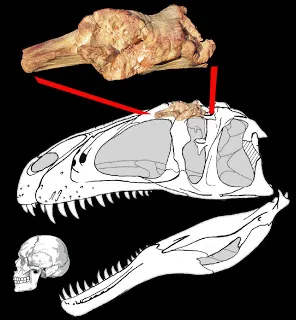New Dinosaur Discovered – Named After the Demonic Sauron from Lord of the Rings
A bizarre skull fragment hints at a new species of giant predatory dinosaur from Morocco
/https://tf-cmsv2-smithsonianmag-media.s3.amazonaws.com/filer/20121102091041sauroniops-thumb.jpg)
Earlier this year, paleontologists Andrea Cau, Fabio Dalla Vecchia and Matteo Fabbri described a strange, 95-million-year-old skull scrap from an unknown dinosaur. Acquired by a commercial collector from Morocco’s Kem Kem beds and later donated to Italy’s Museo Paleontologico di Montevarchi, the bone showed signs that it belonged to a carcharodontosaurid–massive cousins of the familiar Allosaurus. There was something odd about the fossil. The bone was a frontal–situated at the top of the skull just above and in front of the dinosaur’s eye opening–but, unlike the same bone in related species like Carcharodontosaurus, a small dome protruded from the middle of the specimen. No caracharodontosaurid has been found with a dome before.

While a single piece of skull isn’t much to go on, Cau and colleagues nevertheless were able draw on the dome and other subtle features to determine that the frontal didn’t belong to any previously known dinosaur. Still, at the conclusion of their brief Acta Palaeontologica Polonica report, the scientists cautioned against naming a new species from an isolated skull bone. “Although the combination of features present in is unique and should support the institution of a new species,” Cau and coauthors concluded, “pending more complete specimens we feel it would be inappropriate to erect a new taxon.”
Cau, Dalla Vecchia and Fabbri quickly changed their minds. While the rest of the dinosaur remains unknown, after reanalyzing the frontal the paleontologists decided that it was truly unique enough to merit establishing a new name. The subtly-domed dinosaur is now known as Sauroniops pachytholus–the genus name a tribute to the demonic Sauron of the Lord of the Rings series, and the species name for the thick dome on the dinosaur’s head.
I emailed Cau to ask why he changed his mind about the dinosaur so quickly. During the year between the time the two papers were submitted, Cau replied, several papers were published showing that carcharodontosaurids–such as the high-spined Acrocanthosaurus from North America–had frontal bones that were so distinct that they could be use to tell one theropod genus from another. That inspired Cau to take another look at the domed specimen from Morocco.
Ultimately, Cau wrote, “the collected data showed that the unique morphology of our specimen was as diagnostic as those available from the type specimens of other African carcharodontosaurids (e.g., the holotypes of Eocarcharia , Carcharodontosaurus iguidensis , Veterupristisaurus ).” If all these dinosaurs were based on isolated bones, Cau explained, “then there are no real objections for erecting Sauroniops even from a single frontal.”
Frustratingly, though, the limited material means that we only have the barest outline of what Sauroniops was like in life. The size of the frontal, compared to the bone in other carcharodontosaurs, indicates that the dinosaur probably exceeded thirty feet in length. The carnivore was probably just as big as the better-known Carcharodontosaurus, which it lived alongside, but such estimates always await the test of more fossils.
And then there’s the dome. Why did such a large theropod have a prominent bump on its head? In other theropod lineages, such as the abelisaurids, bumps, knobs and horns are common forms of ornamentation. Perhaps the same was true for Sauroniops–thanks to Acrocanthosaurus and the sail-backed Concavenator, we know that carcharodontosaurs showed off with visual signals. Then again, Cau and coauthors speculate that the dome might have been a sexual signal or might have even been used in head-butting behavior. I think the last hypothesis is unlikely, especially since we don’t know what the microstructure of the dome looks like and there’s no evidence of pathology, but it’s still a distant possibility.
So Sauroniops has a name and a family. Like its cousins Kelmayisaurus and Shaochilong, though, we don’t know very much about this dinosaur’s appearance or biology. The lone frontal is a tantalizing glimpse at a dinosaur that paleontologists will have to hunt down in the deserts of Morocco. With some luck, and a lot of persistence, we may eventually become better acquainted with the dome-skulled dinosaur.
For more on this discovery, see Cau’s blog post at Theropoda.
References:
Cau, A., Dalla Vecchia, F., Fabbri, M. 2012. Evidence of a new carcharodontosaurid from the Upper Cretaceous of Morocco. Acta Palaeontologica Polonica 57, 3. 661-665
Cau, A., Dalla Vecchia, F., Fabbri, M. 2012. A thick-skulled theropod (Dinosauria, Saurischia) from the Upper Cretaceous of Morocco with implications for carcharodontosaurid cranial evolution. Cretaceous Research, in press. DOI: 10.1016/j.cretres.2012.09.002
/https://tf-cmsv2-smithsonianmag-media.s3.amazonaws.com/accounts/headshot/RileyBlack.png)
/https://tf-cmsv2-smithsonianmag-media.s3.amazonaws.com/accounts/headshot/RileyBlack.png)